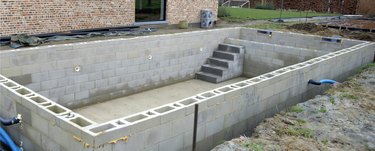
Things You'll Need
Pencil
Tape measure
Bubble level
Electric hammer-drill
Anchor kit
Compressed air
Adjustable wrench
The anchor used to hang heavy objects on a cinder block wall must grip the sides of the anchor's pilot hole tightly. Anchors with heavy-duty spring-loaded wings hold objects against the hollow part of a cinder block, and wedge-style anchors hold objects against the cinder block's solid webbing.
Avoid placing a heavy object's anchor within 1 inch of a cinder block's mortar joint. To safely hold heavy objects against a cinder block wall, use multiple anchors with a total rating 400 percent higher than the object's weight. For example, 2 anchors rated at 100 lbs. can safely hold an object weighing 50 lbs.
Video of the Day
Step 1: Mark the Anchor Placement
Lay out the heavy object's anchor placement and spacing on the cinder block wall with a pencil, using a tape measure and bubble level as a guide. The anchor placement and spacing depend on the heavy object's requirements. Take your time making measurements as some types of anchor, such as the wedge-style anchor, is permanent once it is installed.
Step 2: Install Masonry Drill Bit
Equip an electric hammer-drill with the masonry drill bit included in an anchor kit. Anchor kits contain the proper size masonry drill bit for the anchor's pilot hole.
Step 3: Drill Holes in Cinder Block
Drill the pilot holes into the cinder blocks at the layout marks with the hammer-drill and masonry drill bit. If the drill bit punches through the cinder block's surface and enters a cavity, hang the heavy object with a spring-loaded wing-style anchor. If the drill bit remains in solid material after it passes the 1 1/4-inch depth, hang the heavy object with a wedge-style anchor.
Step 4: Remove Dust from Holes
Clean the dust out of the pilot hole with compressed air.
Step 5: Prepare the Anchor for Installation
Assemble the anchor. If using spring-loaded wing-style anchors, spin the anchor's bolt into the hinged side of the anchor's retaining nut. The anchor's wings fold over the retaining bolt. If using a wedge-style anchor, twist the bolt onto the anchor's threads.
Step 6: Install the Anchor
Insert the end of the anchor opposite the bolt into the pilot hole. If using wing-style anchors, squeeze the wings and press the anchor into the pilot hole. The wings spread once the ends of the wings reach the cinder block's cavity. If using wedge-style anchors, insert the anchor fully and tighten the anchor's bolt with an adjustable wrench until the anchor's ribs expand against the side of the pilot hole.
Step 7: Install the Retaining Device
Place the heavy object's retaining device onto the end of the anchor's bolt. Tighten the bolt, if needed, and install the heavy object. The heavy object's mounting method depends on the type of object and its mounting style.
For example, heavy objects that use a hanging wire, such as mirrors and pictures, use an anchor with its bolt head exposed. Heavy objects that use brackets, such as televisions and fireplace mantels, use anchors with the bolt tightened against the bracket's mounting surface.
Video of the Day